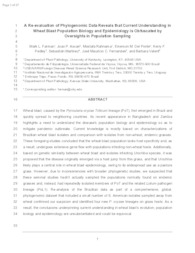A re-evaluation of phylogenomic data reveals that current understanding in wheat blast population biology and epidemiology is obfuscated by oversights in population sampling.
A re-evaluation of phylogenomic data reveals that current understanding in wheat blast population biology and epidemiology is obfuscated by oversights in population sampling.
Author(s): FARMAN, M.; ASCARI, J. P.; RAHNAMA, M.; DEL PONTE, E.; PEDLEY, K. F.; MARTINEZ, S; FERNANDES, J. M. C.; VALENT, B
Summary: Abstract: Wheat blast, caused by the Pyricularia oryzae Triticum lineage (PoT), first emerged in Brazil and quickly spread to neighboring countries. Its recent appearance in Bangladesh and Zambia highlights a need to understand the disease's population biology and epidemiology so as to mitigate pandemic outbreaks. Current knowledge is mostly based on characterizations of Brazilian wheat blast isolates and comparison with isolates from non-wheat, endemic grasses. These foregoing studies concluded that the wheat blast population lacks host specificity and, as a result, undergoes extensive gene flow with populations infecting non-wheat hosts. Additionally, based on genetic similarity between wheat blast and isolates infecting Urochloa species, it was proposed that the disease originally emerged via a host jump from this grass, and that Urochloa likely plays a central role in wheat blast epidemiology, owing to its widespread use as a pasture grass. However, due to inconsistencies with broader phylogenetic studies, we suspected that these seminal studies hadn't actually sampled the populations normally found on endemic grasses and, instead, had repeatedly isolated members of PoT and the related Lolium pathogen lineage (PoL1). Re-analysis of the Brazilian data as part of a comprehensive, global, phylogenomic dataset that included a small number of S. American isolates sampled away from wheat confirmed our suspicion and identified four new P. oryzae lineages on grass hosts. As a result, the conclusions underpinning current understanding in wheat blast's evolution, population biology and epidemiology are unsubstantiated and could be equivocal.
Publication year: 2023
Types of publication: Journal article
Unit: Embrapa Wheat
Observation
Some of Embrapa's publications are published as ePub files. To read them, use or download one of the following free software options to your computer or mobile device. Android: Google Play Books; IOS: iBooks; Windows and Linux: Calibre.
Access other publications
Access the Agricultural Research Database (BDPA) to consult Embrapa's full library collection and records.
Visit Embrapa Bookstore to purchase books and other publications sold by Embrapa.

